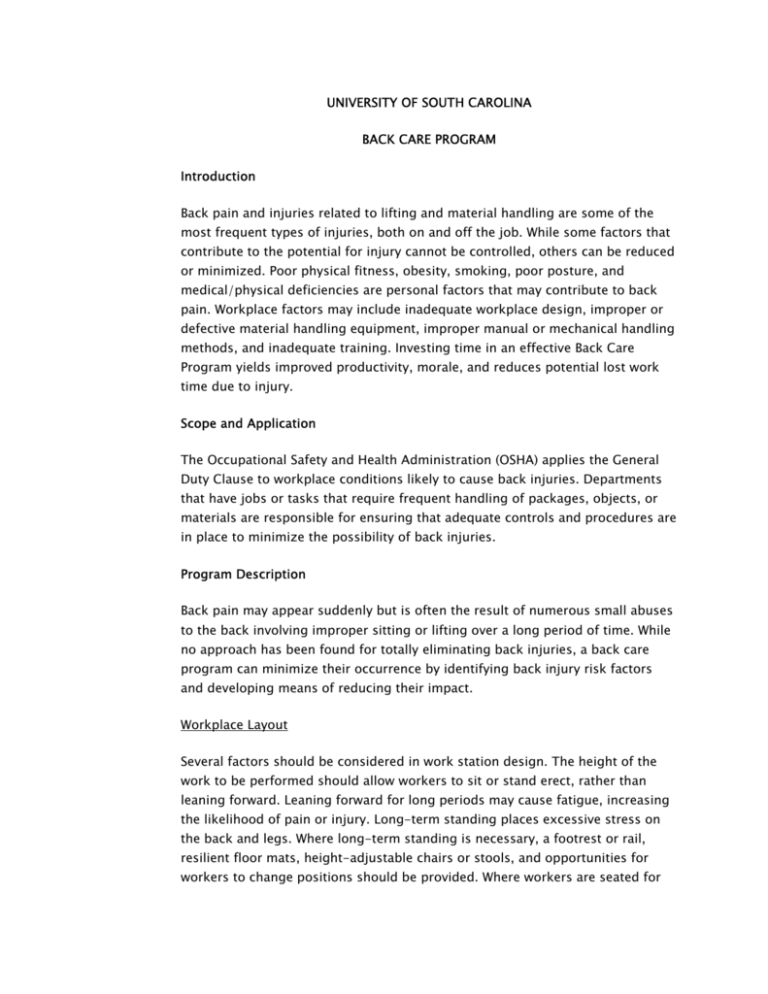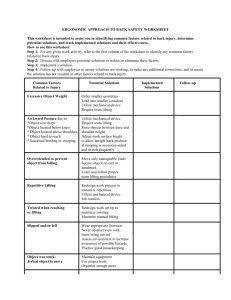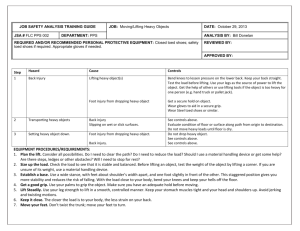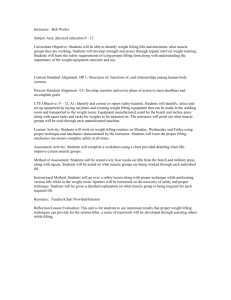Back Safety Guide - University of South Carolina
advertisement

UNIVERSITY OF SOUTH CAROLINA BACK CARE PROGRAM Introduction Back pain and injuries related to lifting and material handling are some of the most frequent types of injuries, both on and off the job. While some factors that contribute to the potential for injury cannot be controlled, others can be reduced or minimized. Poor physical fitness, obesity, smoking, poor posture, and medical/physical deficiencies are personal factors that may contribute to back pain. Workplace factors may include inadequate workplace design, improper or defective material handling equipment, improper manual or mechanical handling methods, and inadequate training. Investing time in an effective Back Care Program yields improved productivity, morale, and reduces potential lost work time due to injury. Scope and Application The Occupational Safety and Health Administration (OSHA) applies the General Duty Clause to workplace conditions likely to cause back injuries. Departments that have jobs or tasks that require frequent handling of packages, objects, or materials are responsible for ensuring that adequate controls and procedures are in place to minimize the possibility of back injuries. Program Description Back pain may appear suddenly but is often the result of numerous small abuses to the back involving improper sitting or lifting over a long period of time. While no approach has been found for totally eliminating back injuries, a back care program can minimize their occurrence by identifying back injury risk factors and developing means of reducing their impact. Workplace Layout Several factors should be considered in work station design. The height of the work to be performed should allow workers to sit or stand erect, rather than leaning forward. Leaning forward for long periods may cause fatigue, increasing the likelihood of pain or injury. Long-term standing places excessive stress on the back and legs. Where long-term standing is necessary, a footrest or rail, resilient floor mats, height-adjustable chairs or stools, and opportunities for workers to change positions should be provided. Where workers are seated for long periods, chairs used should be fully adjustable, support the lower back, and be equipped with arm rests. When seated, knees should be supported slightly higher that hips for good circulation. A foot rest may be used for added height The height of materials to be lifted should be carefully considered. Lifting that occurs below knee level or above shoulder height is more strenuous than lifting between these limits. Adjusting the height of a shelf or pallet, or providing a warehouse ladder, may be necessary to achieve better lifting conditions. Mechanical Aids Mechanical aids should be installed where necessary. Pneumatic lifts, conveyors, and automatic material handling equipment are examples of mechanical aids that can be used to reduce the amount of lifting workers may be expected to do. Training Individuals who engage in lifting and material handling as a part of their work should receive training, including the following: Performing stretching exercises and warm-ups prior to lifting, Taking time to size up the load (e.g. too large or heavy for one person to lift, is the lift necessary, etc.) Using proper lifting techniques (e.g. good grasp, object close to the body, back straight, lift with legs, etc.) Techniques to use for difficult lifting jobs (e.g. oversized loads, lifts over the shoulders or below the knees, etc.) Individuals who are expected to perform manual lifting should also be encouraged to maintain their fitness level by regularly exercising and controlling their weight. Back Belts Back belts are a controversial addition to the techniques used in the prevention of back pain. The goal of back belts is to impose a fixed posture on the wearer, making it difficult or impossible to bend or twist when lifting. There is significant disagreement on the use of back belts, however, with much contradictory evidence regarding their effectiveness. Back belts are not considered personal protective equipment by OSHA and are not specifically covered by existing regulations. The Office of Environmental Health and Safety (EHS) does not recommend the use of back belts. Departments that choose to allow their workers to use back belts should develop a policy on back belt use while considering the following: Back belts are not needed if workers understand and use back care methods, proper lifting techniques, and stay physically fit; Information on the pros and cons of back belts should be made available Participation in any back belt program should be strictly voluntary; to workers prior to purchasing the belt; Back belt use should be permitted only after the worker has received and understood training in back care, safe lifting, exercise, and belt use. Roles and Responsibilities Department Identify operations involving lifting or material handling that may place individuals at risk for back injuries. Institute appropriate engineering controls to reduce injury potential. Provide worker training in proper material handling methods and techniques. Establish back belt use policy. Supervisors Ensure workers are trained. Ensure workers use proper lifting techniques. Enforce back belt use policy. EHS Provide assistance in the evaluation of material handling tasks. Perform evaluations of lifting or material handling operations. Provide training when requested. Individual Attend training. Use proper lifting techniques. Strengthen the back through regular exercise and good physical fitness. For More Information Contact the EHS Employee Safety Coordinator 777-5269. Several informational handouts on back care, safe lifting, and back belts Additional references available through EHS include: are available through EHS. General Duty Clause, Occupational Safety and Health Act, Section 5(a)(1)



